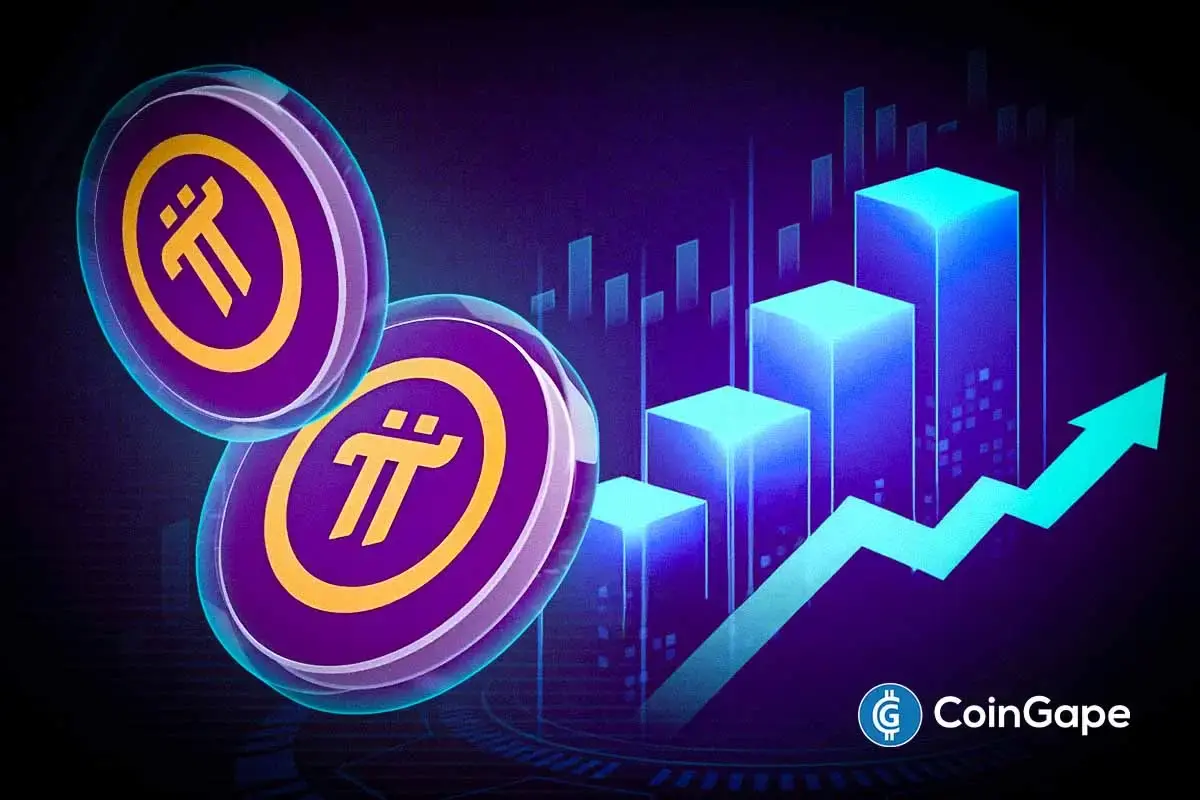Market
Will It Overtake WBTC in DeFi?

Coinbase’s Wrapped Bitcoin (cbBTC) has soared to a $1 billion market cap in just 57 days since its launch.
This growth trajectory effectively represents almost 10% of the Wrapped Bitcoin (WBTC) market cap, which currently sits at $12.88 billion, according to CoinMarketCap.
Coinbase’s cbBTC At $1 Billion Market Cap
Data on Dune shows the cbBTC Bitcoin wrapper has a market capitalization of $1.04 billion as of this writing. The majority of this value is held on Ethereum at $855.43 million, followed by Base Layer-2 blockchain and finally Solana.
Specifically, out of a total cbBTC supply of 14,678.95, over 12,000 are held on Ethereum. Meanwhile, Base and Solana hold 2,388 and 262 tokens, respectively.

As a Bitcoin wrapper, cbBTC allows BTC to be represented on other blockchain networks. Its rise highlights an important trend: Ethereum-based assets experience faster net supply changes than other leading Bitcoin liquid staking tokens (LSTs). These include eBTC, solvBTC, BBN, and pumpBTC, among others.
“The network effect is unbeatable. They can offer rebate/discount/businesses for MMs/Funds in their diversified line of business to bootstrap liquidity, adoption very easily,” said Tom Wan, an on-chain data researcher.
This swift growth, occurring just over two months after launch, signifies a notable demand for Coinbase’s wrapped Bitcoin product. The pace also reflects an escalating preference for cross-chain compatibility within decentralized finance (DeFi).
It comes as users and protocols look for more accessible and flexible Bitcoin-pegged assets. Coinbase first revealed cbBTC’s planned debut on Base in mid-August.
The product inadvertently presented as a prospective market rival to Wrapped Bitcoin (WBTC). The Bitcoin wrapper has also seen increased support and interest across decentralized finance (DeFi).
The idea of a Bitcoin wrapper is to expand users’ access to BTC. For instance, with cbBTC on Solana, holders can leverage the network’s reduced fees and high transaction speeds.
These metrics are especially relevant for high-frequency DeFi transactions. Aave, a leading DeFi protocol, is already targeting cbBTC for its V3 Protocol.
At inception, cbBTC drew attention from venture capitalists like Dan Elitzer. In August, the VC predicted that cbBTC would be “super strategic” for Coinbase. He also said it could outpace WBTC’s supply within six months.
“Frankly, I’m surprised they didn’t ship this years ago,” Elitzer remarked.
Elitzer also emphasized that cbBTC’s introduction could encourage DeFi users to seek more decentralized Bitcoin-wrapped options, given the “mishandling” of WBTC by Justin Sun-affiliated management.
Controversy Surrounding Coinbase’s PoR for cbBTC
Indeed, Coinbase’s cbBTC’s advent came against the backdrop of the WBTC controversy involving Justin Sun. WBTC, once the go-to solution for wrapped Bitcoin on Ethereum, has faced growing skepticism due to concerns over its management and transparency under Justin Sun’s influence.
The rapid rise of cbBTC has not been without controversy. Coinbase’s approach to transparency and Proof of Reserves (PoR) has invited scrutiny. Critics, in particular, remain a bone of contention.
Duo Nine, a popular user on X, warned that Coinbase’s reliance on users’ trust without providing concrete proof of BTC reserves could lead to a collapse similar to the FTX downfall. This outcome, he articulated, was contingent on Coinbase minting more cbBTC than it could back.
“They will not provide any proof of reserves for the BTC they *claim* they have, nor any proof of backing for their new paper BTC called cbBTC. If they print too much paper BTC they will go the FTX route,” Duo Nine said.
Justin Sun echoed the sentiment, raising questions regarding Coinbase’s decision to forgo standard reserve audits for cbBTC. The Tron executive argued that this lack of transparency introduces significant risk. Against such fears, Coinbase’s custodial practices came into question, prompting BlackRock to revise its custody agreement with the exchange.
This unease may have steered users towards alternatives like cbBTC, which some see as a “safer” wrapped Bitcoin option with Coinbase’s backing. As cbBTC attracts more support, it poses an increasing threat to WBTC’s long-standing dominance. Whether cbBTC will eventually surpass WBTC remains to be seen, but its rapid growth signals a significant shift in user preferences within DeFi.
Disclaimer
In adherence to the Trust Project guidelines, BeInCrypto is committed to unbiased, transparent reporting. This news article aims to provide accurate, timely information. However, readers are advised to verify facts independently and consult with a professional before making any decisions based on this content. Please note that our Terms and Conditions, Privacy Policy, and Disclaimers have been updated.
Market
Bitcoin Price Breakout In Progress—Momentum Builds Above Resistance

Reason to trust

Strict editorial policy that focuses on accuracy, relevance, and impartiality
Created by industry experts and meticulously reviewed
The highest standards in reporting and publishing
Strict editorial policy that focuses on accuracy, relevance, and impartiality
Morbi pretium leo et nisl aliquam mollis. Quisque arcu lorem, ultricies quis pellentesque nec, ullamcorper eu odio.
Bitcoin price is slowly moving higher above the $86,500 zone. BTC is gaining pace and might continue higher in the near term.
- Bitcoin found support at $84,200 and started a recovery wave.
- The price is trading above $85,500 and the 100 hourly Simple moving average.
- There was a break above a connecting bearish trend line with resistance at $85,000 on the hourly chart of the BTC/USD pair (data feed from Kraken).
- The pair could start another increase if it clears the $88,000 zone.
Bitcoin Price Eyes Steady Increase
Bitcoin price remained stable above the $83,200 level and started a fresh increase. BTC was able to climb above the $84,200 and $85,000 resistance levels.
There was a break above a connecting bearish trend line with resistance at $85,000 on the hourly chart of the BTC/USD pair. The bulls were able to pump the price above the $86,500 resistance. It even spiked above $87,000. A high is formed near $87,562 and the price might continue to rise unless there is a move below the 23.6% Fib retracement level of the upward move from the $84,007 swing low to the $87,562 high.
Bitcoin price is now trading above $86,500 and the 100 hourly Simple moving average. On the upside, immediate resistance is near the $87,500 level. The first key resistance is near the $88,000 level.
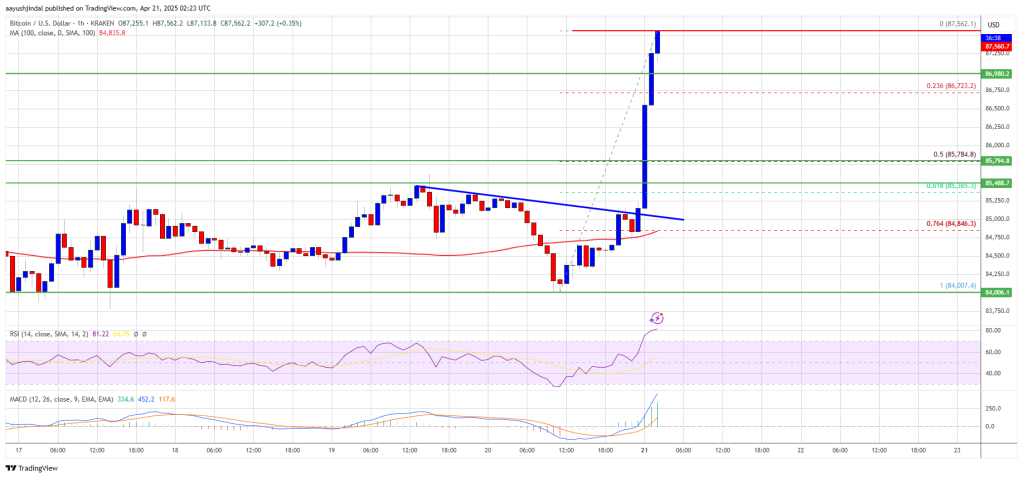
The next key resistance could be $88,800. A close above the $88,800 resistance might send the price further higher. In the stated case, the price could rise and test the $89,500 resistance level. Any more gains might send the price toward the $90,000 level.
Downside Correction In BTC?
If Bitcoin fails to rise above the $88,000 resistance zone, it could start a downside correction. Immediate support on the downside is near the $87,000 level. The first major support is near the $86,750 level.
The next support is now near the $86,000 zone. Any more losses might send the price toward the $85,750 support or the 50% Fib retracement level of the upward move from the $84,007 swing low to the $87,562 high in the near term. The main support sits at $84,850.
Technical indicators:
Hourly MACD – The MACD is now gaining pace in the bullish zone.
Hourly RSI (Relative Strength Index) – The RSI for BTC/USD is now above the 50 level.
Major Support Levels – $86,750, followed by $86,000.
Major Resistance Levels – $87,500 and $88,000.
Market
Will XRP Break Support and Drop Below $2?

XRP is down 5% over the past week, struggling to regain momentum as technical indicators flash mixed signals. Its Relative Strength Index (RSI) has dropped below 50, and the price remains stuck within a tight range between key support and resistance levels.
At the same time, the Ichimoku Cloud has shifted from green to red, with a thickening cloud ahead suggesting growing bearish pressure. With volatility compressing and momentum fading, XRP is nearing a critical point where a breakout—or breakdown—seems increasingly likely.
XRP Struggles to Regain Momentum as RSI Drops Below 50
XRP’s Relative Strength Index (RSI) is currently sitting at 44.54, after recovering from an intraday low of 40.67. Just yesterday, it was at 51.30, highlighting increased short-term volatility.
RSI is a momentum indicator that measures the speed and magnitude of recent price changes to evaluate overbought or oversold conditions.
Readings above 70 typically suggest an asset is overbought, while readings below 30 indicate it may be oversold.

With XRP’s RSI at 44.54, it’s currently in neutral territory, showing neither strong buying nor selling pressure.
However, the fact that it hasn’t crossed the overbought threshold of 70 since March 19—over a month ago—signals a lack of sustained bullish momentum. This could mean XRP is still in a consolidation phase, with the market waiting for a clearer direction.
If RSI continues to climb toward 50 and beyond, it may hint at building momentum, but without a breakout above 70, upside could remain limited.
XRP Faces Uncertainty as Bearish Trend Begins to Expand
XRP is currently trading inside the Ichimoku Cloud, signaling market indecision and a neutral trend.
The Tenkan-sen (blue line) has crossed below the Kijun-sen (red line), which is a bearish signal, but with the price still within the cloud, it lacks full confirmation.
The cloud itself acts as a zone of support and resistance, and XRP is now moving sideways within that zone.
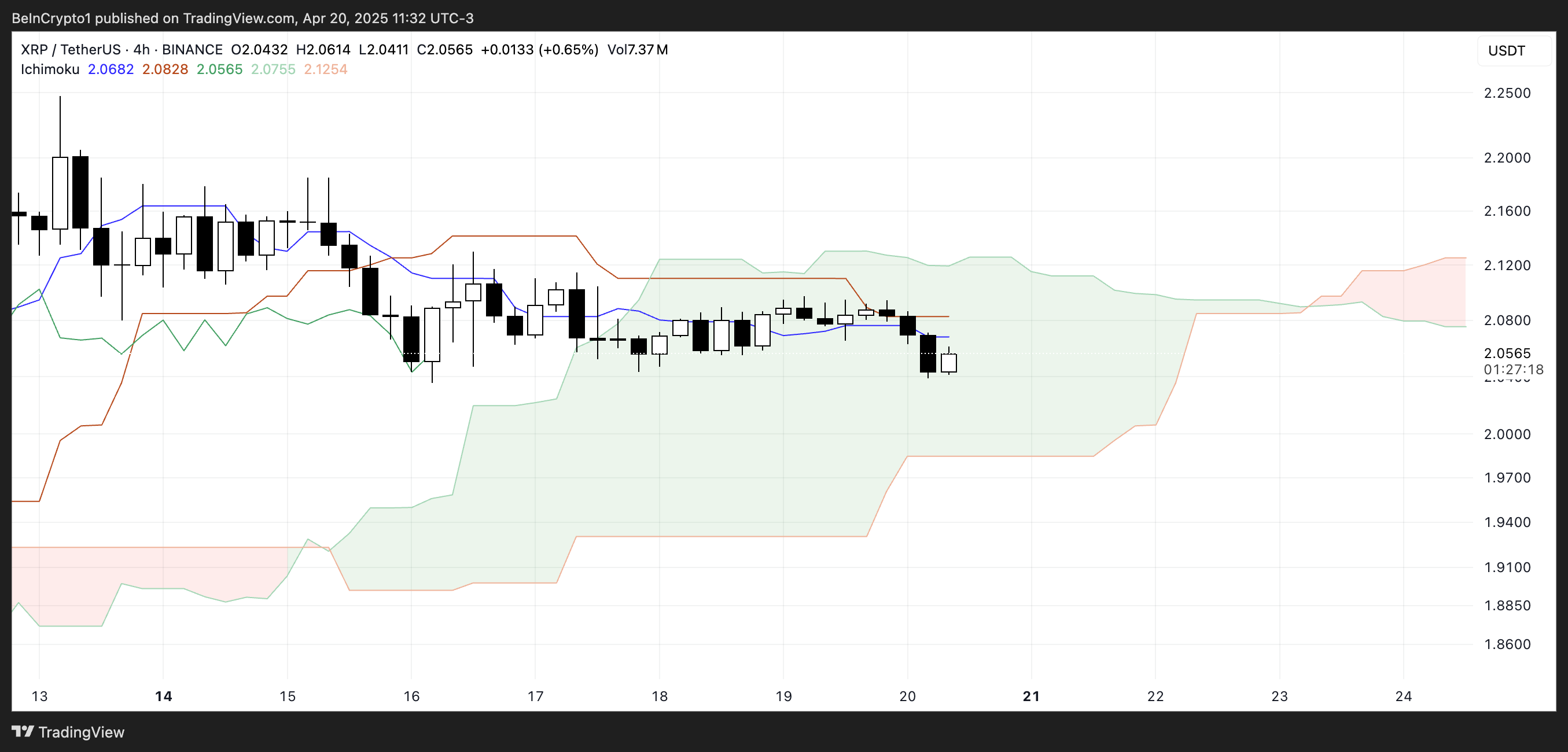
Looking ahead, the cloud has shifted from green to red—a sign that bearish momentum may be building. Even more concerning is that the red cloud is widening, which suggests increasing downward pressure in the near future.
A thickening red Kumo often signals stronger resistance overhead and a potential continuation of a bearish trend if the price breaks below the cloud.
Until XRP breaks out decisively in either direction, the market remains in a wait-and-see phase, but the growing red cloud tilts the bias toward caution.
XRP Compression Zone: A Breakout Could Send Price to $2.50 — Or Much Lower
XRP price is currently trading within a tight range, caught between a key support level at $2.05 and resistance at $2.09. This narrow channel reflects short-term uncertainty, but a decisive move in either direction could set the tone for what’s next.
If the $2.05 support fails, the next level to watch is $1.96. A break below that could trigger a steep drop toward $1.61, which would mark the first close below $1.70 since November 2024—a bearish signal that could accelerate selling pressure.
Recently, veteran analyst Peter Brandt warned that a major correction could hit XRP soon.

On the flip side, if bulls regain control and push XRP above the $2.09 resistance, the next target lies at $2.17. A breakout beyond that could open the door to a move toward $2.50, a price level not seen since March 19.
For that to happen, XRP would need a clear resurgence in momentum and buying volume.
Until then, the price remains trapped in a narrow zone, with both upside and downside potential on the table.
Disclaimer
In line with the Trust Project guidelines, this price analysis article is for informational purposes only and should not be considered financial or investment advice. BeInCrypto is committed to accurate, unbiased reporting, but market conditions are subject to change without notice. Always conduct your own research and consult with a professional before making any financial decisions. Please note that our Terms and Conditions, Privacy Policy, and Disclaimers have been updated.
Market
Dogecoin Defies Bullish Bets During Dogeday Celebration
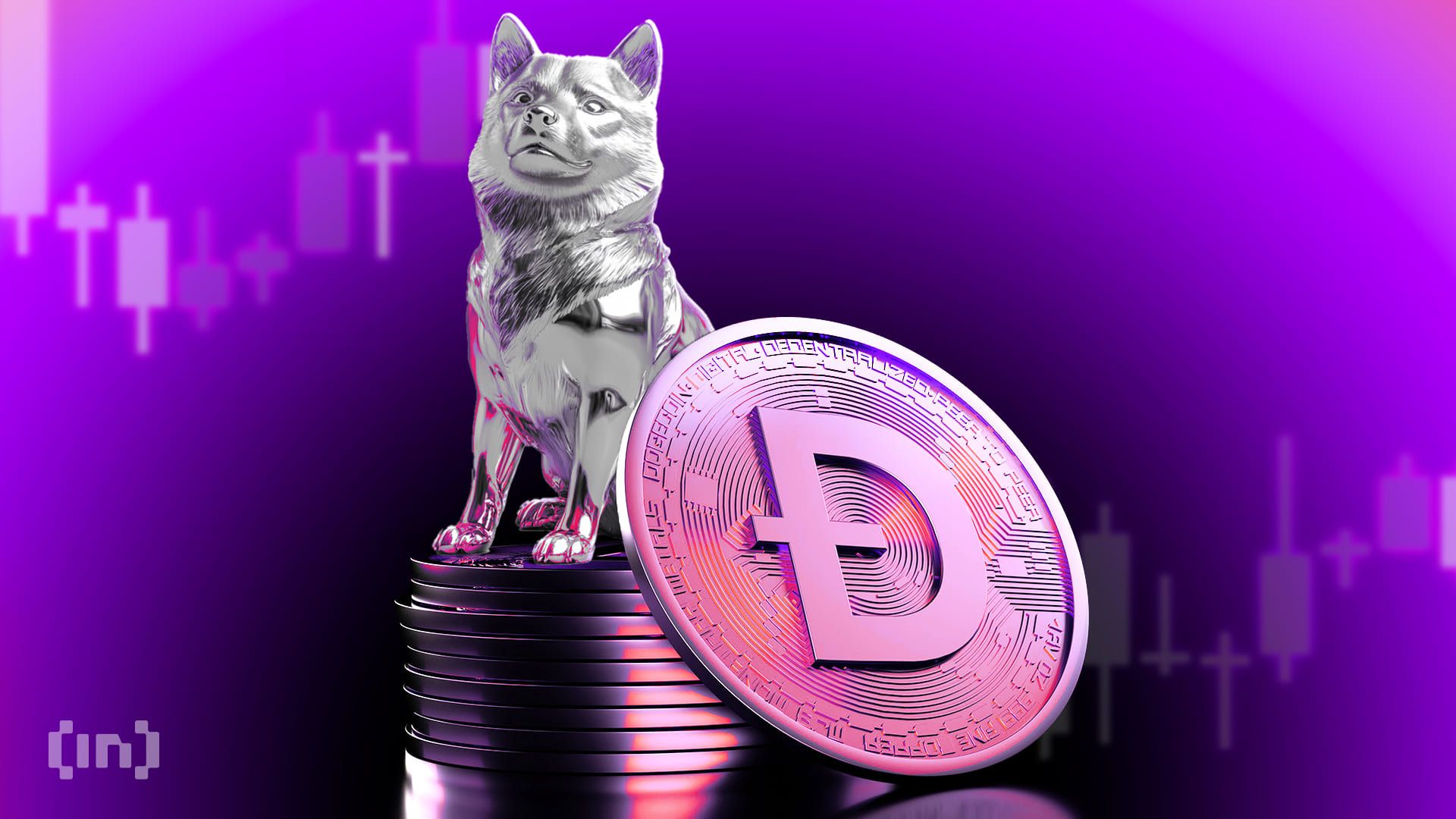
On April 20, Dogecoin enthusiasts worldwide united to mark Dogeday, a community-driven holiday celebrating the world’s most recognizable meme coin.
While the festivities showcased the coin’s loyal fanbase and cultural relevance, the celebration failed to spark any meaningful market movement.
Dogeday Fails to Lift Dogecoin Price as Traders Face $2.8 Million in Liquidations
Instead of riding a wave of positive sentiment, Dogecoin was the worst-performing asset among the top 20 cryptocurrencies during the past day.
According to data from BeInCrypto, the token dropped over 2.5% during the reporting period compared to the muted performance of the general market.
This disappointing performance led to roughly $2.8 million in liquidations, with traders betting on an upward price movement losing more than $2 million, per Coinglass figures.

However, even with the lackluster price action, Dogecoin’s relevance in the crypto ecosystem remains undeniable. Launched in 2013 as a parody of Bitcoin, DOGE has grown far beyond its meme origins.
The digital asset is now the ninth-largest cryptocurrency by market capitalization, currently valued at approximately $22.9 billion, according to CoinMarketCap.
Much of its growth can be attributed to high-profile endorsements. Tesla CEO and presidential advisor Elon Musk has repeatedly voiced support for Dogecoin, as has billionaire entrepreneur Mark Cuban. Their backing helped shift public perception of DOGE from a joke to a legitimate digital asset and payment option.
On social media, Dogecoin continues to lead the memecoin narrative. According to CryptoRank, it was the most mentioned memecoin ticker on X (formerly Twitter) in the past month. This visibility continues to fuel both community engagement and investor interest.
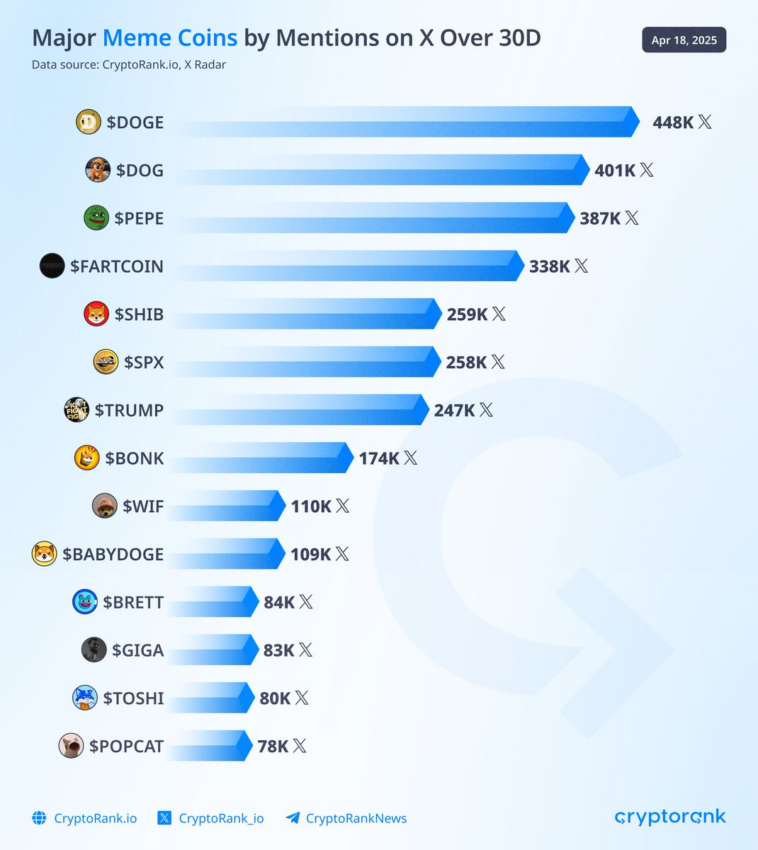
Moreover, institutional interest in Dogecoin is also on the rise. Major asset managers, including Bitwise, Grayscale, 21Shares, and Osprey, have submitted filings to the US Securities and Exchange Commission (SEC) seeking to launch spot Dogecoin ETFs.
If granted, these financial investment vehicles could become the first exchange-traded funds centered entirely on a meme coin.
Considering this, crypto bettors on Polymarket put the odds of these products’ approval above 55% this year. This optimism reflects a growing belief that Dogecoin could soon secure a place in mainstream financial markets.
Disclaimer
In adherence to the Trust Project guidelines, BeInCrypto is committed to unbiased, transparent reporting. This news article aims to provide accurate, timely information. However, readers are advised to verify facts independently and consult with a professional before making any decisions based on this content. Please note that our Terms and Conditions, Privacy Policy, and Disclaimers have been updated.
-
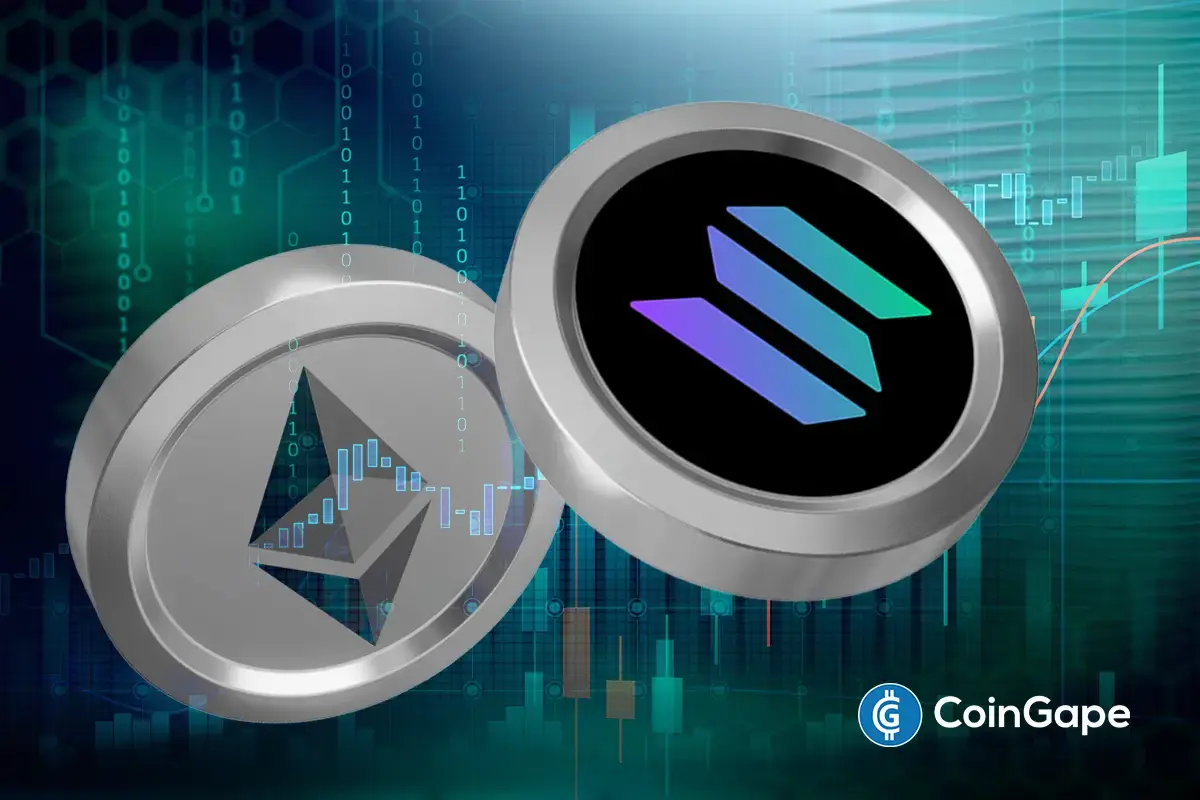
 Altcoin21 hours ago
Altcoin21 hours agoUniswap Founder Urges Ethereum To Pursue Layer 2 Scaling To Compete With Solana
-

 Market18 hours ago
Market18 hours agoToday’s $1K XRP Bag May Become Tomorrow’s Jackpot, Crypto Founder Says
-
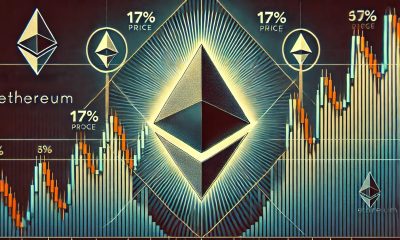
 Ethereum18 hours ago
Ethereum18 hours agoEthereum Consolidates In Symmetrical Triangle: Expert Predicts 17% Price Move
-
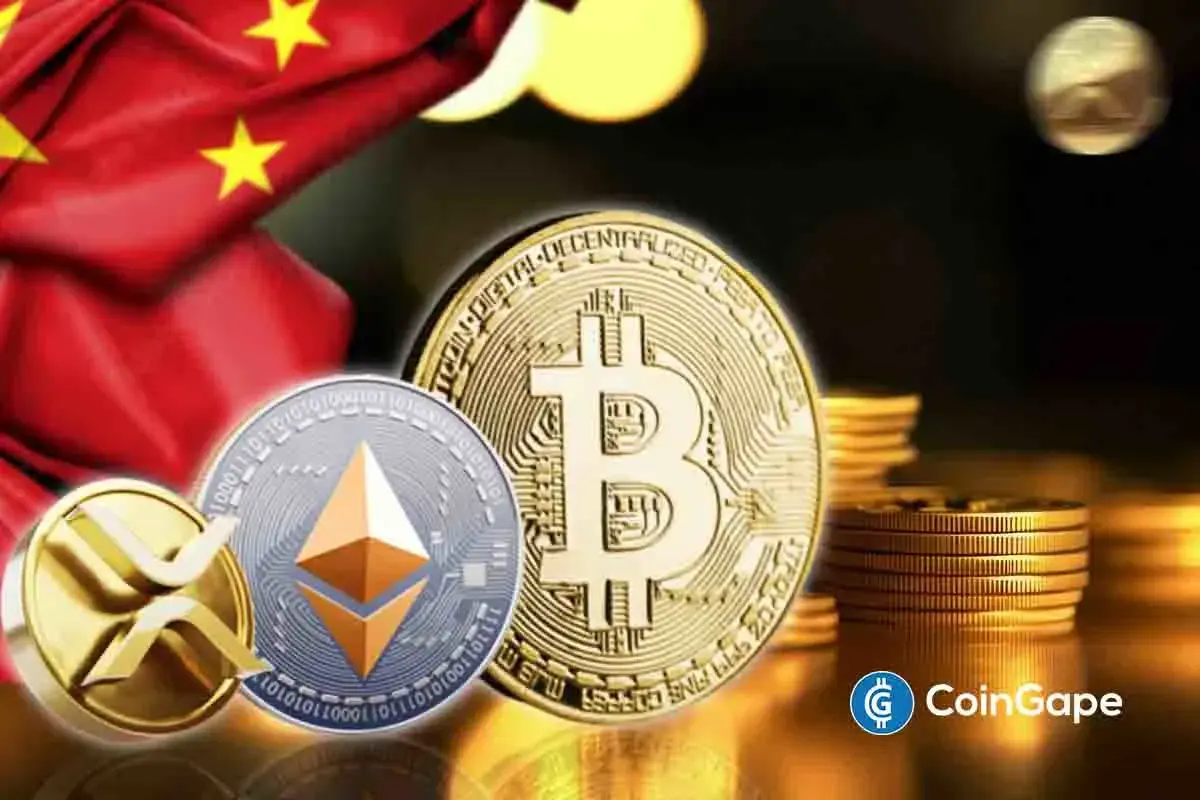
 Altcoin20 hours ago
Altcoin20 hours agoWhat’s Up With BTC, XRP, ETH?
-

 Market11 hours ago
Market11 hours ago1 Year After Bitcoin Halving: What’s Different This Time?
-

 Market12 hours ago
Market12 hours agoVOXEL Climbs 200% After Suspected Bitget Bot Glitch
-

 Ethereum20 hours ago
Ethereum20 hours agoEthereum Accumulators At A Crucial Moment: ETH Realized Price Tests Make-Or-Break Point
-

 Ethereum17 hours ago
Ethereum17 hours agoEthereum Enters Historic Buy Zone As Price Dips Below Key Level – Insights


















